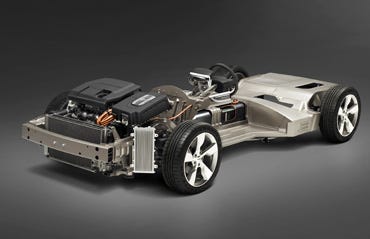March 19, 2009


The upcoming Chevrolet Volt’s sophisticated T-shaped battery pack is designed to do more than simply deliver energy to the car’s electric motor; it also will serve as a key structural element of the vehicle’s chassis, General Motors Corp. reveals.
In its latest backgrounder on its first extended-range electric vehicle due in late 2010, GM stops short of providing a full-scale peek inside the Volt’s lithium-ion battery, but it does show off what’s underneath – reinforcements that meld the pack with the rest of the chassis to improve body rigidity and keep the casing out of harm’s way in the event of a collision.
In a webinar conducted for the media, GM engineers show a bottom-up view of the Volt’s underpinnings during several stages of a front-impact crash test. While the front end collapses, the battery pack remains largely unaffected.
The metal reinforcements across the pack “carry crash loads from side to side and help to securely retain over 400 lbs. (181 kg) of battery,” says Andrew Farah, chief engineer for the Volt. “That’s important in a crash situation.”
The design allows the pack to be positioned down the spine of the car and close to the ground, providing the Volt with a center of gravity that is lower than other standard models sharing its base Delta architecture, Farah says. This improves handling and cornering.
GM designed the pack to load into the vehicle from the bottom, just like the rear axle and other chassis components, to avoid undue manufacturing complexity.

Volt’s chassis.
“This way we don’t have to redesign the way a vehicle is made in the assembly plant,” Farah says.
The auto maker promises to give a close-up look inside the pack nearer to production, but for now says it consists of more than 200 individual Li-ion cells, a thermal management system, sensors and controls. GM says the compact package achieves an industry-best 94% thermal efficiency.
“You have to treat the cells right from a thermal standpoint,” says Robert A. Kruse, executive director of global vehicle engineering-hybrids, electric vehicles and batteries. “Our understanding is extremely sophisticated.”
The auto maker worked with Compact Power Inc., the U.S. arm of South Korean Li-ion cell supplier LG Chem Ltd., on the pack design, and now considers the thermal management system and the in-house developed electronic controls and software a core competency.
GM took a modular approach to the battery system, which potentially will enable it to use the basic Li-ion cells in a wide range of vehicles across its lineup.
Individual modules, consisting of cells, the thermal management system, sensors and control mechanisms, will work in a smaller number of vehicles that match certain design criteria, GM says. And the completed pack will be compatible with other models from the same front-drive architecture as the Volt.
“We’re putting some basic building blocks on our shelf and will reuse them in other vehicles,” Farah says.
Meanwhile, the GM engineers say they favor development of a rapid-charging infrastructure over schemes centered on providing quick substitutions of depleted batteries for fully charged ones. The latter strategy is being promoted by companies such as California-based Project Better Place, which is working with Renault SA and Nissan Motor Co. Ltd. on a proposal to set up quick-change battery outlets to support the two auto makers’ EV launches in Israel and other countries.
GM says the Volt initially will be able to recharge fully in three hours using a 220-volt electric line, and the auto maker is working on reducing that in future generations of its Li-ion technology.
“Yes, we are working on rapid-charging scenarios,” Kruse says. “Having an infrastructure for rapid charging seems much more viable and a much greater opportunity than battery swapping, but we’ll let the marketplace decide.”
The Massachusetts Institute of Technology recently revealed it had discovered a breakthrough in Li-ion battery technology that in theory would allow an EV to be recharged in five minutes. MIT has been working with Li-ion battery supplier A123Systems Inc., which lost out in the initial Volt contract to LG Chem but continues to work with GM on potential future applications.
About the Author
You May Also Like